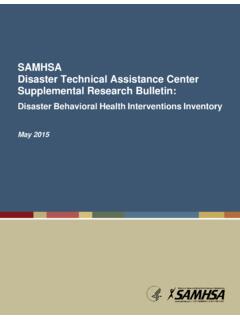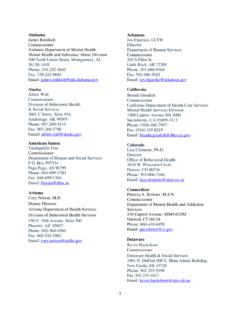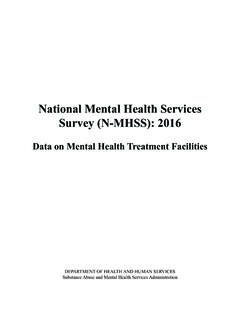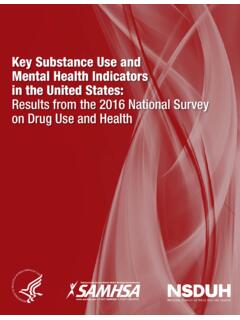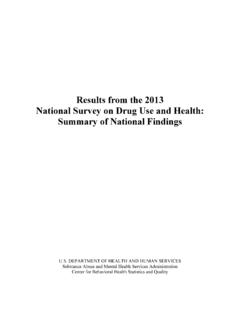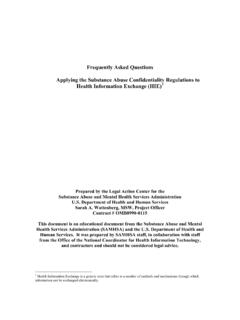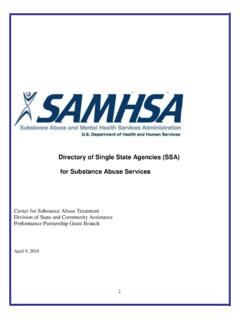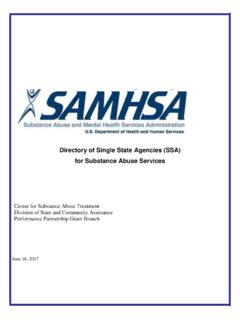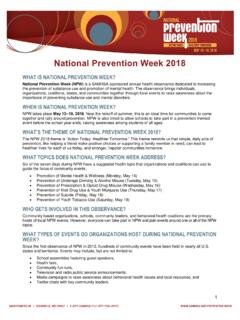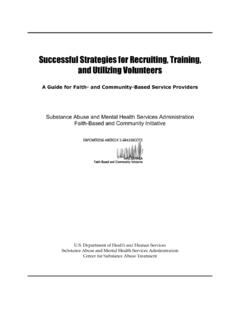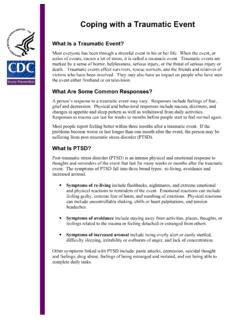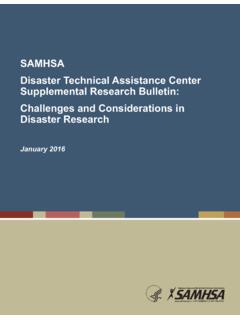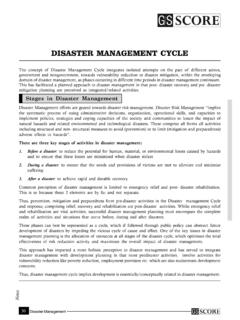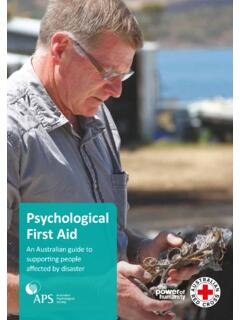Transcription of First Responders: Behavioral Health Concerns, Emergency ...
1 SAMHSAD isaster Technical Assistance Center Supplemental Research BulletinFirst responders : Behavioral Health Concerns, Emergency Response, and TraumaMay 2018 CONTENTSINTRODUCTION 3 BACKGROUND First responders Behavioral Health 4 Behavioral Health Conditions in Emergency Medical Services Personnel 4 Depression 4 Stress and Posttraumatic Stress Disorder/Symptoms 4 Suicide/Suicide Ideation 5 Behavioral Health Conditions in Firefighters 5 Depression 5 Stress and Posttraumatic Stress Disorder/Symptoms 6 Substance Use 6 Suicide/Suicide Ideation 6 Behavioral Health Conditions in Police Officers 7 Depression 7 Stress and Posttraumatic Stress Disorder/Symptoms 7 Substance Use 7 Suicide/Suicide Ideation 7 RISK AND PROTECTIVE FACTORS FOR Behavioral Health IN First responders 8 Pre- disaster /Event Risk and Protective Factors 8 Risk and Protective Factors During the disaster /Event 8
2 Post- disaster /Event Risk and Protective Factors 9 INTERVENTIONS TO REDUCE Behavioral Health RISKS FOR First responders 10 General and Institutional Interventions 10 Preparedness 10 Response 11 Public Health Intervention Models 11 CONCLUSION 12 REFERENCES 13 The focus of the Supplemental Research Bulletin is to provide an overview of the current literature on a specific topic and make it easy to understand for disaster Behavioral Health professionals who are not otherwise exposed to the research. The product aims to assist professionals and paraprofessionals involved in all-hazards planning, disaster Behavioral Health response and recovery, and/or Crisis Counseling Assistance and Training Program grant activities.| Page 3 INTRODUCTIONThis issue of the Supplemental Research Bulletin focuses on mental Health and substance use ( Behavioral Health ) concerns in First responders .
3 It is estimated that 30 percent of First responders develop Behavioral Health conditions including, but not limited to, depression and posttraumatic stress disorder (PTSD), as compared with 20 percent in the general population (Abbot et al., 2015). In a study about suicidality, firefighters were reported to have higher attempt and ideation rates than the general population (Stanley et al., 2016). In law enforcement, the estimates suggest between 125 and 300 police officers commit suicide every year (Badge of Life, 2016). First responders are usually the First on the scene to face challenging, dangerous, and draining situations. They are also the First to reach out to disaster survivors and provide emotional and physical support to them. These duties, although essential to the entire community, are strenuous to First responders and with time put them at an increased risk of trauma.
4 The purposes of this publication are to discuss the challenges encountered by First responders during regular duty as well as following disasters; shed more light on the risks and Behavioral Health consequences (such as PTSD, stress, and depression) of serving as a First responder; and present steps that can be taken to reduce these risks either on the individual or institutional who are among the First to respond to a disaster are referred to by different terms, depending on whether the speaker and audience are part of federal government, state and local government, or other entities, and they may not be clearly defined at all. According to Title 6 Domestic Security of the Code, First responders include these individuals and groups:The term Emergency response providers includes Federal, State, and local governmental and nongovernmental Emergency public safety, fire, law enforcement, Emergency response, Emergency medical (including hospital Emergency facilities), and related personnel, agencies, and authorities (Domestic Security, 2010).
5 The terms First responders and public Health workers (the term used in some papers) are somewhat arbitrary; the terms include police, firefighters, search and rescue personnel, and Emergency and paramedical teams (Benedek, Fullerton, & Ursano, 2007). For the purpose of this publication we will concentrate on three major groups that will be discussed separately whenever possible or combined under the term First responders : Emergency medical services (EMS) Firefighters Police officersThis issue of the Supplemental Research Bulletin is based on literature and scientific publications found through the National Center for Biotechnology Information and National Library of Medicine (PubMed). All research cited in this issue was published in English, and most was conducted in the United States (with a few exceptions where investigations in other countries proved useful to the topic).
6 We did not include literature on trauma related to military service, as the challenges and types of danger and training are different. We also did not include literature on nontraditional First responders because the literature was not robust.| Page 4 BACKGROUND First responders Behavioral HEALTHP rotecting the population s Health is a vital part of preserving national security and the continuity of critical national functions. However, public Health and public safety workers experience a broad range of Health and mental Health consequences as a result of work-related exposures to natural or human-caused disasters (Benedek et al., 2007). First responders involved in these occupations are exposed to hazards inherent in the nature of their jobs (Plat, Frings-Dresen, & Sluiter, 2011). Examples include exposure (direct or indirect) to death, grief, injury, pain, or loss as well as direct exposure to threats to personal safety, long hours of work, frequent shifts and longer shift hours, poor sleep, physical hardships, and other negative experiences (Botha, Gwin, & Purpora, 2015; Heavey et al.)
7 , 2015; Marmar et al., 2006; Patterson et al., 2012; Quevillon, Gray, Erickson, Gonzalez, & Jacobs, 2016).Many natural or technological disasters produce overwhelming disruption to the social, familial, economic, and physical structure of the affected community (Mitchell, 2011; Miller, 2011). disaster response is usually made up of a wide array of professional and volunteer organizations with varying levels of disaster experience. Collateral damage, or the intra- and interpersonal disturbances that arise from disaster work, can be observed among both professional and volunteer First responders (Mitchell, 2011). Behavioral Health Conditions in Emergency Medical Services PersonnelOne of the core risk factors for First responders is the pace of their work. First responders are always on the front line facing highly stressful and risky calls.
8 This tempo can lead to an inability to integrate work experiences. For instance, according to a study, 69 percent of EMS professionals have never had enough time to recover between traumatic events (Bentley et al., 2013). As a result, depression, stress and posttraumatic stress symptoms, suicidal ideation, and a host of other functional and relational conditions have been is commonly reported in First responders , and rates of depression as well as severity vary across studies. For instance, in a case-control study of certified EMS professionals, depression was reported in percent, with mild depression the most common type ( percent) (Bentley et al., 2013). Among medical team workers responding to the great East Japan earthquake (2011), percent were diagnosed with clinical depression (Garbern, Ebbeling, & Bartels, 2016).
9 In a study in Germany, percent of Emergency physicians had clinical depression (Pajonk, Cransac, Muller, Teichmann, & Meyer, 2012).STRESS AND POSTTRAUMATIC STRESS DISORDER/SYMPTOMSS tress symptoms and posttraumatic stress symptoms in EMS personnel have been reported in a number of studies. For instance, in a review of published literature, EMS/paramedics reported higher peritraumatic dissociation at the time of the Loma Prieta Bay Area earthquake (1989) compared with the police (Marmar et al., 2006). In a study in Germany, percent of Emergency physicians had probable PTSD (Pajonk, Cransac, Muller, Teichmann, & Meyer, 2012). In a case-control study among certified EMS professionals, stress was reported in percent, with mild stress the most common type ( percent) (Bentley et al., 2013).| Page 5 SUICIDE/SUICIDE IDEATIONS uicidal ideation has been reported in First responders in a number of studies, but there is still a question as to the rates given the way data has been collected in samples of convenience versus the use of random samples.
10 However, existing research suggests that EMS personnel may be more likely than the general population to think about and attempt suicide. For instance, in a literature review, suicidal thoughts and ideations in EMS/paramedics were evaluated as compared to the general population (Stanley, Hom, & Joiner, 2016). Based on findings from a study included in the review only two studies of suicidality in EMS personnel met the criteria for the review authors found a lifetime prevalence rate of 28 percent for feeling life is not worth living, percent for serious suicidal ideation, and percent for a past suicide attempt (Stanley, Hom, & Joiner, 2016). In another study in the same review, it was found that having both EMS and firefighting duties was associated with a sixfold increase in the likelihood of reporting a suicide attempt as compared to firefighting alone (Stanley et al.)
